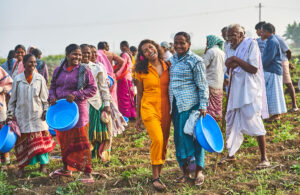
Diaspora Co – Building a Better, Equitable Spice Trade
Creating an equitable spice trade by disrupting an outdated trade system and putting money and power into the hands of Indian farmers.
USA
Monica Janvier November 23, 2020
Based in South San Francisco, CA, Chief Science Officer Nate Storey co-founded Plenty, an indoor vertical farming company with the mission to improve the health of people, plants, and the planet. This mission was inspired by the unpredictability of farming on fields and the increasing human population.
Flavor is one of their top priorities. Their pesticide-free and non-GMO crops are grown with a texture, freshness, and optimal flavor that is unique to their growing process. Products are grown hydroponically — without soil—while also prioritizing cleanliness, making them ready-to-eat without being washed. Plenty also creates controlled environments—managing specific levels of temperature and light— which create perfect “climates” catered to each specific plant grown. This indoor growing process allows their seasonal products to be grown year-round as pests, seasons, and climate play no factor.
Mood of Living: Where did you grow up?
Nate Storey : Wyoming – I was an Air Force brat. We moved around a lot when I was growing up. But my family spent the most time stationed in Wyoming, and that’s where I called home and eventually settled.
Nate Storey
MoL : Where did you go to school? What did you study?
NS: University of Wyoming, Bachelors – Ph.D., Bachelors in Agroecology, and Masters and Ph.D. in Agronomy.
MoL: When and why did you become interested in agriculture and food science?
NS: My family has its roots in agriculture- my father’s generation was the first without strong ties to ranching, but the idea of agriculture and that connection to the land was in my blood. After high school, I made an eclectic list of things and found myself living in China. In China (in an agricultural village about 100Km outside of Beijing), I decided I wanted to do something around farming and feeding people. I was staying in an apartment on the second story overlooking the village threshing floor. Every day, women from the village would come to that threshing floor and work to prepare the food – dry, thresh, shuck, whatever they needed to do. I watched how their labor shifted with the seasons. I felt like that work was honest and straightforward – just the kind of thing I wanted to do.
Plenty – Tigris Farm
MoL : How did you meet your co-founder, Matt Barnard? What inspired you to create Plenty together? What is Plenty’s mission?
NS: I met Matt at an indoor conference. At the time, I was working on a vision to get people excited about starting small farms with indoor technology. But that turned out to be more challenging than it sounded. Not everyone wants to go into farming, and not everyone interested in agriculture has the business experience to run a farm. I was beginning to think about how to impact more people with a larger farming organization, on a timescale shorter than my lifetime. That’s when I met Matt, who was trying to address the enormous water consumption required by agriculture. The result of that meeting led to what would eventually become Plenty. Plenty’s mission is to improve the lives of people, plants, and the planet.
MoL: What is vertical farming? How is your company different from other vertical farming companies?
NS: Vertical farming is a form of farming that grows crops in buildings on towers or vertical stacks of beds instead of flat on the ground. Most companies stack grow beds that are flat on top of each other to maximize the space. Plenty is the only one that grows on vertical towers instead of flatbeds. We have a pretty unique architecture because we wanted to build a more efficient platform than the traditional approach.
Plenty is trying to solve one of the most vexing problems of our time – how do we grow more food in a world with shrinking arable land, less freshwater, and a more extreme environment? We believed that we had to create more land, grow crops with a fraction of the water, and protect crops from the environment. We went on to create the vertical farm designs that we’re using today.
We created a new indoor farming architecture that works with the plants’ behavior, the physics of the space, and the people who take part in the growing process. This vertical tower architecture is a vast improvement over stacked layers, which struggle with adequate airflow to achieve optimal crop yield and flavor. Our farm is capable of delivering the highest yield of any other farm, whether indoor or conventional. For example, Plenty’s Tigris farm can grow one million plants at a time and process 200 plants per minute, using less than 5% of the water and 1% of the land required by traditional farming.
We all want to eat vegetables and have a healthy diet, but after decades of extended supply chains, processed food, and artificial flavors, we have forgotten how fresh produce can and should taste. For me, eating something fresh from the garden has always been a joy, a jolt of life, not a chore. I want people to experience the same thing when they taste the produce that we grow. To make sure this is true, we’ve built an R&D facility that is continuously researching how we make our produce grow and taste better, and we’ve hired a team of flavor experts who think about flavor all day. They’re like a sommelier for vegetables. They keep us consistent, focused, and make sure what’s coming out of the farm has the potential to give our customers the joy and the flavor experience that we want them to have. Because of the incredibly fine-tuned control we have, we can make that experience consistently, repeatedly awesome.
Eating healthy should be joyful. We’re trying to bring back the joy of great flavor that many of us have lost.
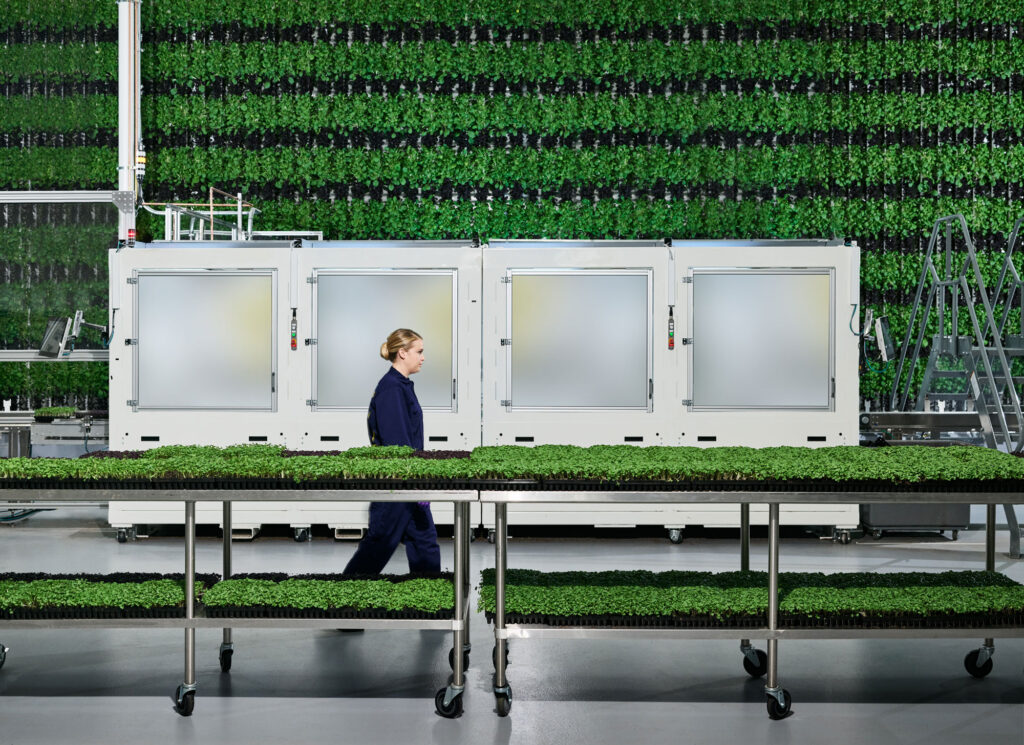
MoL: What products do you grow and what sets them apart?
NS: Today we grow four main crops:
Our leafy greens are grown in a way that allows us to control their flavor precisely. Flavor and nutrition are closely linked because our products are natural and unprocessed. As we control all elements, we can grow plants that have great nutrition, and as a result, have great flavor. We also harvest at the height of their tastiness and deliver directly to the store, so the taste and texture are super fresh like you picked it from your garden, and it stays that way for a while.
MoL: As an indoor vertical farming company, how are your products grown?
NS: We start with seeds. We take those seeds and plant them in trays filled with medium made out of peat moss and increasingly shredded coconut husk. These trays are then watered and sent into big, warm, humid tents while we wait for the seed coat to crack and the seed to germinate. Once the plant has germinated, we grow the seedling out on racks, and then a robot grabs the plug and places it into the growing tower. We use a mixture of software and data analytics, and brilliant growers to continually monitor the plant’s growth. Our custom-designed lights provide the perfect spectrum to maximize growth, flavor, and nutrition. The towers move and spread apart as they travel through the farm, giving the ideal amount of light and space to grow. Once the plant gets to the end of the line, it’s ready to be harvested. Robots take it off the tower, cut it, and then we package the greens. Then they quickly get put into a van for delivery to local stores.
MoL: What are LED lights and what are the benefits of using them?
NS: We’re pretty proud of our lights. Because plants are incredibly sensitive to light intensity and range, we designed and built proprietary LED lights that feature a unique spectrum. Over the past 20 years, the agriculture industry has learned a lot about how light impacts a plant. In the same way that we use a keyboard to type in a computer command, we use light to send commands to the plant.
We can make them change shape, stretch, grow roots or shoots, and tap into that plant’s best tasting version. We’ve spent a lot of time researching how we can use light and all of the other parts of the plant environment to coax them into tasting awesome.
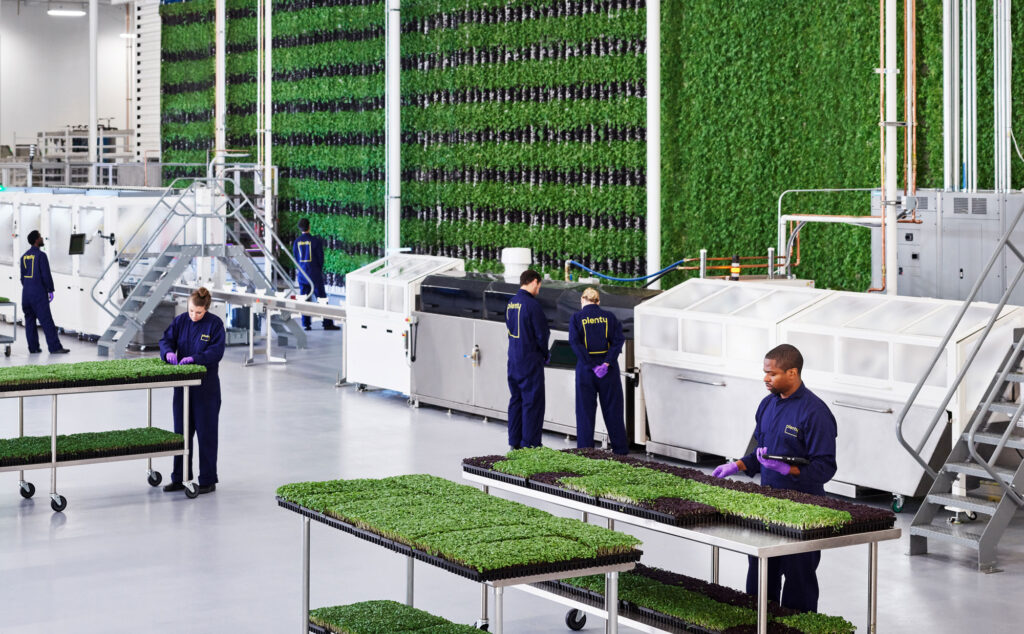
MoL: How does Plenty reduce water consumption and accomplish zero waste? And how does this benefit the planet?
NS: The world is heading towards a water crisis. We are extracting groundwater at up to 300 times the replenishment rates — an alarmingly unsustainable practice. For example, the Ogallala aquifer provides over 30 percent of the nation’s irrigation water and drinking water to nearly two million people across eight states in the Great Plains and High Plains region. However, it will run out of usable water in the next 20 to 30 years. That aquifer takes about 6,000 years to replenish. That’s a long time to wait to irrigate crops, fill water towers, and have clean drinking water again.
In the field, 99 percent of the water we give the plant evaporates, and most of the water goes right back into the atmosphere. Therefore, even with conservative irrigation, agriculture is dependent on a LOT of water to grow food. We knew we wouldn’t have much to work with, so we designed our system to capture almost all of the water that we would lose in the field. In Plenty’s system, towers are irrigated from the top, and the water runs down the towers, moistening the plants, and then, at the bottom, is captured and recirculated. We also capture all of that water vapor (99% of the water the plants consume), condense it, and put it back into the circulation systems. Our system condenses thousands of gallons per day and recirculates it back into the irrigation system, effectively saving almost all of the water we send to our plants.
We also use recyclable and compostable materials in our farm like the coconut husk that holds the seedling while it germinates. It’s an agricultural waste from coconut production that we upcycle into a medium for our plants. That husk is used in our seed trays and is an excellent material for helping our seeds through the first few days.
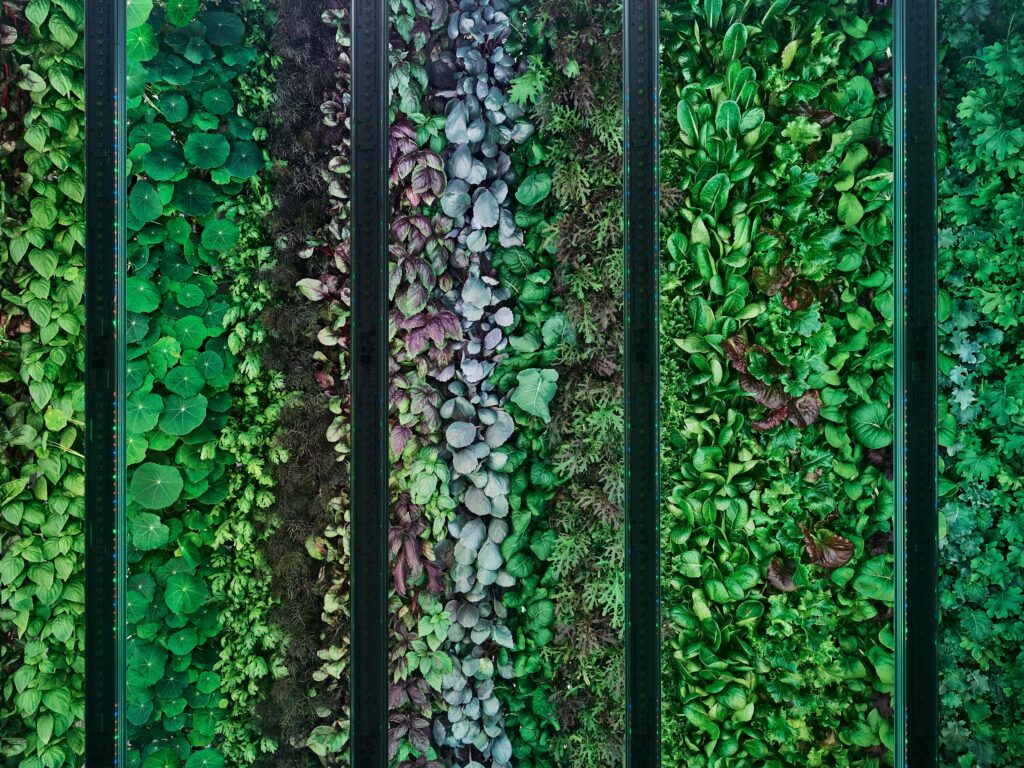
MoL: You recently partnered with the grocery store company, Albertsons. What motivates this decision? What are your goals?
NS: Albertsons is a national grocery retailer. Partnering with them gives us a way to get our products out to more consumers. We worked out a multi-year, fixed volume agreement with Albertsons, which is unprecedented in the grocery business.
They initially chose us because they loved the flavor of our products. The Albertsons team came to the farm and did a taste test of the products. Then we did a pilot in a few stores. Plenty was selling at a category-leading pace because their shoppers loved the products. Then COVID hit, and the food supply chain broke down. However, even in the thick of a food supply crisis, we could consistently supply their stores and ramp up production to meet increased demand. I think that’s when they saw the real value of Plenty. Growing in an automated, indoor, controlled, local farm made it much easier to keep growing and supplying without interruption. We demonstrated that we could deliver a delicious product with consistent quality and quantity, even when the food chain is stressed.
MoL: How does Plenty improve food security, safety, and availability?
NS: The U.S. Department of Agriculture estimates that 90 percent of crop losses in the country are caused by extreme weather, like flooding, which destroyed about $3 billion worth of crops and farmland in January 2020 alone. Bacteria and pathogen outbreaks caused the number of food recalls in the U.S. to increase by 10% between 2013-2018. We are dealing with an increasingly stressed system.
Countries worldwide are experiencing higher levels of food insecurity as the impacts of flooding and famine in rich countries get exported to global food markets with dollars. Countries like China and the U.S. can afford to buy food elsewhere to feed their people. Other countries can not- especially when prices rise due to instability in other parts of the world. Also, we see more disasters from pests, like the locusts devouring crops in Kenya this year. Weather, water shortages, and problems will only increase as demands are placed on the land to yield more, with less, for more people.
Indoor farms are protected from floods, frost, pests, droughts, most pathogens, and extreme weather. If every country can start utilizing indoor farming, they can have a secured food source when they need it, or sell their crops to others when they don’t.
We’re building our next farm in Compton, California. Compton has a rich agricultural history. It once was a place with a thriving farming community. Yet, ironically, it has now become a food desert. By building an indoor farm in Compton, we can provide year-round manufacturing jobs and affordable access to healthy greens for the community.
Food access and security are areas that Plenty takes very seriously, and it’s in the DNA of our business. It’s why we do what we do.
MoL: What were some challenges you faced when co-founding Plenty? What are the challenges you face now during the pandemic?
NS: When we were getting started, we were trying to build something that hadn’t been done before. When you’re trying to change the oldest industry in the world, people think you’re crazy. There were no experts who could test it, validate it, or even understand it. No one knew the difference between one way of vertical farming versus another. We had to educate people on the technology, the concept, the cost curves, and the long-term opportunity. That meant educating everyone on the challenges of farming in a world about to drive off a climate cliff. We need to grow more food with less land and water.
Once people understand the opportunity in vertical farming, the possibilities become endless. It can change the way we feed the world. Our challenge has been picking where to focus first.
The pandemic has actually grown sales and demonstrated the benefit of indoor farming. We did not experience the labor and supply chain disruptions that the food chain experienced elsewhere because of our automated and local model. Our farm is immaculate and one of the safest places to be during the pandemic. We were already using PPE as standard practice, so we didn’t have to change much beyond exercising extra caution and making sure our teams were managed in a way that kept them safe.
MoL: What advice can you give to those who want to create positive change?
NS: My advice is to pick something simple that matters and stay the course. We live in a society that encourages and rewards short-term attention spans and short term rewards. The most challenging, most meaningful endeavors don’t accommodate either. I was drawn to farming because it’s honest, slow, long-term work. Changing the way people or the world do anything is slow, long-term work. There’s rarely an opportunity for instant gratification.
Pick something important to you and keep at it. It starts small and gets more prominent over time. Perseverance is how you create positive change
MoL: Since creating your company, are you leading a more conscious lifestyle? If so, how?
NS: In some ways, yes, in other ways, I have a lot of work to do. When I first started having to fly more, I felt guilty about my carbon footprint.
Two years ago, I started a project where I developed a carbon sequestration plan and calculated a planting schedule over time that would fully offset my carbon footprint. In total, it’s a 40-year commitment.
Every year, I plant a few thousand trees. Still, I have to keep up the planting for another 18 years to stick to the plan and then wait for another 20 for my forest to mature, but it’s coming along well, and hand-planting 50-100 trees every night is an incredibly de-stressing activity.
I also dabble in regenerative grazing to try and use cows to imitate buffalo herds and then calculate how much more carbon can be stored in the soil as a result- it’s pretty fun stuff. On a personal level, I’m working on small things, like being grateful every day and remembering why I do what I do, spending time with my family, and gaining perspective while remaining conscious of the world around me. It’s the small stuff that’s the hardest.
Photography and video courtesy Plenty

Creating an equitable spice trade by disrupting an outdated trade system and putting money and power into the hands of Indian farmers.

Founded by Helen and Mike Cameron, Uncommon Ground is America’s first certified organic rooftop farm.
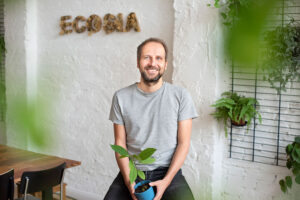
Ecosia, founded by Christian Kroll, is a sustainable search engine that turns searches into trees and is notably the first-ever German B-Corp.